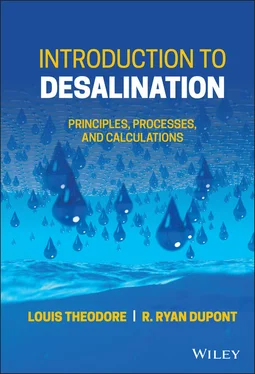Irrigation field practices – Techniques that keep water in the field, more efficiently distribute water across the field, or encourage the retention of soil moisture.
Irrigation withdrawals – Withdrawal of water for application on land to assist in the growing of crops and pastures.
Isothermal – A term used to describe a process that exhibits no change in temperature, i.e. constant temperature.
Lagooning – The placement of solid or fluid material in a basin, reservoir, or artificial impoundment for purposes of treatment, storage, or disposal.
Lake – An inland body of fresh or saltwater of considerable size, occupying a basin on the Earth’s surface.
Land application – The discharge of wastewater onto the ground surface for treatment or disposal.
Leaching – A process by which something is removed by percolating, or trickling liquid; it usually refers to the removal of components in soil by water.
Leachate – Any liquid, including any suspended components in the liquid, that has percolated through or drained from a solid, such as liquid generated from waste in a landfill.
Leakage – An undesired and gradual escape or entry of a fluid into or out of a tank or vessel.
Levee – A dike or ridge at the side of a river, intended to protect the land side from flood waters or to confine the stream flow to its regular channel.
Limnetic zone – The well-lit, open-water surface region of a lake away from shore.
Limnology – The scientific study of the physical, chemical, and biological components of freshwater with emphasis on plants and animal life.
Liquid – An amorphous, noncrystalline state of matter; the molecules of which are much more highly concentrated than in gases and usually less concentrated than in solids.
Liquid permeation – The movement of liquid components from one side of a membrane to the other.
Liquid-liquid extraction – The separation of a solute based on its relative solubility in two immiscible liquids, usually water and an organic solvent.
Low-flow showerhead – A showerhead that produces 2.5 gallons per minute or less, as compared to the 4.5 gallons per minute produced by most older standard showerheads.
Low-flush toilet – A toilet that requires 1.6 gallons of water per flush or less, as compared to the 3.5 to 5 gallons of water required to flush most older, standard toilets.
Magma – The molten material within the Earth’s crust that is composed of silicates and volatiles (water and gases) in complex solution.
Make-up water – The water that is employed to replenish a system that loses water through leakage, evaporation, etc.
Manifold – A pipe fitting with numerous branches to convey fluids between a large pipe and several smaller pipes or to permit the choice of diverting flow from one of the several sources or to one of the many discharge points.
Mantle – The part of the interior of the Earth between the crust and the core.
Maximum contaminant level (MCL) – A maximum allowable level of a compound within a treated drinking water deemed safe for human consumption; concentrations above this level are deemed unsafe and unacceptable for human consumption.
Membrane – A thin sheet of material through which a gaseous or liquid solution may pass.
Membrane hydrolysis – A hydrolysis process that occurs when a colloidal electrolyte is separated from pure water by a membrane.
Membrane selectivity – The ability of a membrane to allow passage of only anions or cations.
Microorganism – An organism of microscopic size generally considered to include bacteria, algae, protozoa, fungi, and rotifers but excluding viruses; they (primarily bacteria) are employed in biological wastewater treatment processes to remove biodegradable organic matter and suspended solids. Some species are human pathogens and are removed by water and wastewater treatment to prevent disease transmission and protect public health.
Mine water – The water encountered in mining operations that, if discharged into surface streams or other bodies of water, often contaminates them and makes them unfit for beneficial use.
Mineral spring – A spring that contains high levels of mineral salts.
Miscibility – The ability of a liquid or gas to dissolve uniformly in another liquid or gas.
Monitoring – A periodic or continuous surveillance or testing to determine the level of compliance with statutory requirements and pollutant levels in various media, or in living things.
Monitoring well – A well drilled to collect groundwater samples for analysis to determine the amounts, types, and distribution of contaminants in the groundwater.
Mother liquor – A concentrated solution that is substantially freed from undissolved matter by filtration, centrifuging, or decantation; the product can be obtained by evaporation and/or crystallization.
Municipality – A city, town, borough, county, parish, district, or other public body.
Natural resources – The land, fish, wildlife, biota, air, water, groundwater, drinking water supplies, and other such resources belonging to, managed by, held in trust by, pertaining to, or otherwise controlled by the United States.
Navigable water – Any stream, lake, arm of the sea, or other natural body of water that is navigable and of sufficient capacity to float watercraft for the purposes of commerce, trade, transportation, or recreation, as indicated under the Clean Water Act.
Nitrates – Oxidized nitrogen that forms a monovalent anion; is the form of nitrogen that is produced from the aerobic oxidation of ammonia (nitrification); and that serves as an electron acceptor for the anaerobic oxidation of organic matter (denitrification); it is a nutrient that can result in eutrophication of lakes and ponds and is the cause of “blue baby” syndrome in humans if in high concentrations in drinking water: its MCL is 10 mg/L in drinking water.
Nonpoint source – A source of pollutant discharge that is not traceable to a discrete location.
Non-potable water – Water considered unsafe and/or unpalatable for drinking (see also potable water).
Nutrient – Any element or compound that is essential to the life and growth of plants or animals, either as such or as transformed by chemical or enzymatic reactions; nitrogen and phosphorous are the major nutrients of concern in polluted waters.
Ocean water (seawater) – A uniform solution contained approximately 96.5% water and 3.5% ionized salts; ingestion of substantial amounts will create a bodily chloride imbalance with harmful effects.
Oceanic – A term used to describe the parts of the oceans deeper than 200 meters.
Oceanography – The science dealing with oceans, including their form, physical and chemical features, and related phenomena.
Open channel – Any natural or artificial waterway or conduit in which a fluid flows with a free surface exposed to atmospheric pressure.
Osmosis – The passage of a pure liquid (usually water) through a semipermeable membrane from a solution of low concentration into a solution of a higher concentration (e.g. the flow of pure water into a solution of salt and water); see also reverse osmosis.
Osmotic pressure – The pressure that results from osmosis.
Outfall – The place where an effluent is discharged into a receiving water.
Outfall sewer – A pipe or conduit that transports wastewater effluent to a final point of discharge.
Oxygenation – The increase of the dissolved oxygen content within water through aeration.
Ozonation – The addition of ozone to a water supply to reduce taste and odor problems and for disinfection.
Ozonator – A device that creates ozone from oxygen and adds it to water.
Parts per billion (ppb) – The fraction (ppbm for mass fraction and ppbv for volume fraction) multiplied by 109; it is a unit used to measure extremely small concentrations of a substance; equivalent to units of µg/L in water.
Читать дальше












